Diyala Project
Visit the Diyala Archaeological Database
News: National Endowment for Humanities (NEH) awards $100,000 in funding to the Diyala Project in its "Recovering Iraq's Past" Initiative (September 15, 2004). See the University of Chicago press release.
Table of Contents
Statement of Significance and Impact
- Project Description
- Project Activities and Methodology
- Project Results
- Project Team
- Proposed Plan for Completion of Project
- Annual Reports and On-line Publications
- Bibliography
- Object Photos (Selection)
Significance and Impact of the Diyala Project
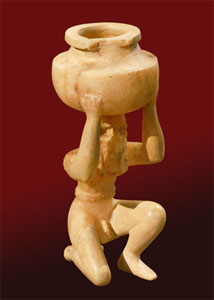 With the Diyala on-line database, the Oriental Institute will launch an innovative, web-based publication of fundamentally important archaeological data from ancient Mesopotamia (modern Iraq).
With the Diyala on-line database, the Oriental Institute will launch an innovative, web-based publication of fundamentally important archaeological data from ancient Mesopotamia (modern Iraq).
I. Project Description
1. Significance of Diyala Excavations
By the early twentieth century sensational archaeological finds had put Iraq onto the archaeological map of the world. Yet early excavations often lacked a systematic approach to digging and recording, 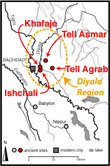 paying little attention to stratigraphy (the super-imposed cultural phases of an archaeological site). Objects recovered in those early excavations became prized museum items, but selective sampling and poor record-keeping of archaeological proveniences rendered many of them useless for functional analyses of architectural units, making it difficult to establish a reliable chronological sequence of cultural artifacts. This was the situation when the Oriental Institute launched its Diyala Expedition
paying little attention to stratigraphy (the super-imposed cultural phases of an archaeological site). Objects recovered in those early excavations became prized museum items, but selective sampling and poor record-keeping of archaeological proveniences rendered many of them useless for functional analyses of architectural units, making it difficult to establish a reliable chronological sequence of cultural artifacts. This was the situation when the Oriental Institute launched its Diyala Expedition 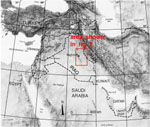 in 1930, in which four sites (Tell Agrab, Tell Asmar, Ishchali, Khafaje) in the Diyala Region northeast of Baghdad were excavated (Figures 1, 2). Over the following six years a team of archaeologists uncovered temples, palaces, domestic quarters, and workshops dating between 3200 and 1800 B.C., a crucial time span during which large territorial states emerged in Mesopotamia, large urban centers developed, and writing was invented. The data recovered during these excavations exposed a cross-section through most aspects of urban life in ancient Mesopotamia, such as its political organization, religion and cult, social organization, and economic interactions. In spite of the large scale of excavations, exceptional care was taken with the systematic recording of find contexts, using procedures that were uncommon at that time in Near Eastern archaeology. Architectural spaces such as rooms, courtyards, or corridors were divided into loci, clearly defined spatial units that were given unique numbers. This recording system not only helped to establish a sound chronological framework for artifacts based on their archaeological provenience, but also made it possible to identify the functions of distinct spatial units within a building by studying their artifact patterns. Such a precision in data recording has been surpassed only in the past twenty years through use of computers on projects of this scope in Mesopotamian archaeology, a fact that highlights the significance of this data.
in 1930, in which four sites (Tell Agrab, Tell Asmar, Ishchali, Khafaje) in the Diyala Region northeast of Baghdad were excavated (Figures 1, 2). Over the following six years a team of archaeologists uncovered temples, palaces, domestic quarters, and workshops dating between 3200 and 1800 B.C., a crucial time span during which large territorial states emerged in Mesopotamia, large urban centers developed, and writing was invented. The data recovered during these excavations exposed a cross-section through most aspects of urban life in ancient Mesopotamia, such as its political organization, religion and cult, social organization, and economic interactions. In spite of the large scale of excavations, exceptional care was taken with the systematic recording of find contexts, using procedures that were uncommon at that time in Near Eastern archaeology. Architectural spaces such as rooms, courtyards, or corridors were divided into loci, clearly defined spatial units that were given unique numbers. This recording system not only helped to establish a sound chronological framework for artifacts based on their archaeological provenience, but also made it possible to identify the functions of distinct spatial units within a building by studying their artifact patterns. Such a precision in data recording has been surpassed only in the past twenty years through use of computers on projects of this scope in Mesopotamian archaeology, a fact that highlights the significance of this data.
2. History of Publication
Following the end of the excavations in 1937, several printed volumes were prepared for publication, but World War II interrupted this work and dispersed the group of scholars that had worked in the field. Persistent analysis by a few of the collaborators between 1939 and 1988, however, produced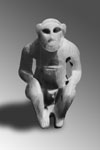 monographs on
monographs on 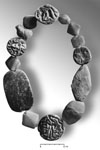 almost all of the architecture and some of the major finds (statuary, cylinder seals, pottery). Over 12,000 objects, however, have so far remained unpublished. According to the excavators’ publication schedule, they would have appeared in a volume called “Miscellaneous Objects from the Diyala Region.” In the past decades several attempts were started to publish this material, but the large number of objects made data management difficult if not impossible. Perhaps it is fortunate that this book never materialized—its title would have severely understated the significance of this material which, after all, represents the large majority of finds from the Diyala excavations, consisting of objects that touched upon all sections of Mesopotamian life. Among these items are stone vessels, tools, weapons, jewelry, cosmetic sets, weights, figurines, stone and metal vessels, inlays, and stamp seals (Figures 3, 4, 5). Many of these items are truly artworks, while others provide valuable information of everyday life. In addition, some 1,200 clay tablets with cuneiform texts written in the Sumerian and Akkadian languages and over 250 clay sealings with impressions, many of them also bearing inscriptions, have also remained unpublished (Figure 6). In the division of finds undertaken by Iraq Museum authorities during the 1930s, half of the objects had been allocated to the Oriental Institute, the other half to the Iraq Museum. Most of the objects had been photographed and described in the field, resulting in thousands of unpublished photographs, field object registers, and catalogue cards that detail the Diyala holdings of both the Iraq Museum and the Oriental Institute (Figure 7).
almost all of the architecture and some of the major finds (statuary, cylinder seals, pottery). Over 12,000 objects, however, have so far remained unpublished. According to the excavators’ publication schedule, they would have appeared in a volume called “Miscellaneous Objects from the Diyala Region.” In the past decades several attempts were started to publish this material, but the large number of objects made data management difficult if not impossible. Perhaps it is fortunate that this book never materialized—its title would have severely understated the significance of this material which, after all, represents the large majority of finds from the Diyala excavations, consisting of objects that touched upon all sections of Mesopotamian life. Among these items are stone vessels, tools, weapons, jewelry, cosmetic sets, weights, figurines, stone and metal vessels, inlays, and stamp seals (Figures 3, 4, 5). Many of these items are truly artworks, while others provide valuable information of everyday life. In addition, some 1,200 clay tablets with cuneiform texts written in the Sumerian and Akkadian languages and over 250 clay sealings with impressions, many of them also bearing inscriptions, have also remained unpublished (Figure 6). In the division of finds undertaken by Iraq Museum authorities during the 1930s, half of the objects had been allocated to the Oriental Institute, the other half to the Iraq Museum. Most of the objects had been photographed and described in the field, resulting in thousands of unpublished photographs, field object registers, and catalogue cards that detail the Diyala holdings of both the Iraq Museum and the Oriental Institute (Figure 7).
3. Creation of a Computer Database
In 1992, with the support of an NEH grant, McGuire Gibson launched the Diyala Project as a computer-based database project. Using DBase 3 and 4, students entered data from field object catalogues and object cards into database files, while volunteers started scanning thousands of object photographs taken during the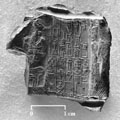
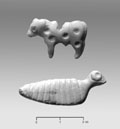 excavation. The initial data entry was done into flat files, but their limitations soon became apparent. Quite often, several units of information had to be entered in one field. More often than not, for example, archaeological objects were composed of more than one material; some of them may had been assigned to more than one “descriptive” or “functional” category by the excavators; some objects had been photographed once, others many times. The problems with our flat-file data structure grew when information from cuneiform texts was entered. Clay tablets with a single account, receipt, or distribution list can record dozen of manufactured, received, or traded commodities; any such operations would have involved many people whose names also could be listed in the text. Needless to say, many of these information units were only relevant to one particular type of object—personal names, for example, only show up in written texts. The need for a complex relational database layout, which would allow us to store such units of information as distinct entries in searchable and sortable form, became apparent. When we changed our supporting database software in 1995 to Microsoft FoxPro, initial structural changes were implemented. When several project members moved from entering catalogue data to analytical work on artifacts for dissertation and paper research, however, the need for a much more dynamic data layout that went far beyond our initial concept became apparent. Soon after Clemens Reichel started analyzing personal names on cuneiform
excavation. The initial data entry was done into flat files, but their limitations soon became apparent. Quite often, several units of information had to be entered in one field. More often than not, for example, archaeological objects were composed of more than one material; some of them may had been assigned to more than one “descriptive” or “functional” category by the excavators; some objects had been photographed once, others many times. The problems with our flat-file data structure grew when information from cuneiform texts was entered. Clay tablets with a single account, receipt, or distribution list can record dozen of manufactured, received, or traded commodities; any such operations would have involved many people whose names also could be listed in the text. Needless to say, many of these information units were only relevant to one particular type of object—personal names, for example, only show up in written texts. The need for a complex relational database layout, which would allow us to store such units of information as distinct entries in searchable and sortable form, became apparent. When we changed our supporting database software in 1995 to Microsoft FoxPro, initial structural changes were implemented. When several project members moved from entering catalogue data to analytical work on artifacts for dissertation and paper research, however, the need for a much more dynamic data layout that went far beyond our initial concept became apparent. Soon after Clemens Reichel started analyzing personal names on cuneiform 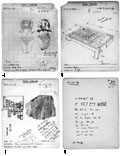 texts from the governor's palace of Eshnunna (the ancient name of Tell Asmar) for his dissertation, he discovered the existence of genealogical continuity in certain office holdings that extended over four generations. He also noted that the activities of many officials could be correlated with the archaeological findspots of the cuneiform texts, allowing the reconstruction of ancient office locations and even “paper trails.” Reichel quickly learned to appreciate the usefulness of related database files while trying to reconstruct hundreds of family lines. Stored procedures, integrated into the structural layout of the database, allowed him to update his genealogical diagrams automatically each time he entered a new text. In short, what initially had been conceived of as a publication database was expanded rapidly into a sophisticated research database, allowing highly individualized data management for such different object categories as stone vessels, inlays, cylinder seals, sealings, weights, and cuneiform texts. By 2001 our database contained over sixty major tables, managed and navigated by over 2,000 programs, procedures, and screens.
texts from the governor's palace of Eshnunna (the ancient name of Tell Asmar) for his dissertation, he discovered the existence of genealogical continuity in certain office holdings that extended over four generations. He also noted that the activities of many officials could be correlated with the archaeological findspots of the cuneiform texts, allowing the reconstruction of ancient office locations and even “paper trails.” Reichel quickly learned to appreciate the usefulness of related database files while trying to reconstruct hundreds of family lines. Stored procedures, integrated into the structural layout of the database, allowed him to update his genealogical diagrams automatically each time he entered a new text. In short, what initially had been conceived of as a publication database was expanded rapidly into a sophisticated research database, allowing highly individualized data management for such different object categories as stone vessels, inlays, cylinder seals, sealings, weights, and cuneiform texts. By 2001 our database contained over sixty major tables, managed and navigated by over 2,000 programs, procedures, and screens.
Years of work have shown clear results. In June 2001 Reichel, who has acted as the project’s coordinator and its data architect since 1999, submitted his dissertation "Political Changes and Cultural Continuity at the Palace of the Rulers in Tell Asmar (Eshnunna) from 2070 to 1850 B.C." His ground-breaking synthesis, which depended almost exclusively on the Diyala database as source material, proved that our concept of a publication and research-oriented database worked.
II. Project Activities and Methodology
1. Revised Publication Plan: A “Virtual Diyala Archive”
While the publication of the objects remains our primary goal, we also began to see another potential of a web-based publication: the creation of a “Virtual Diyala Archive.” Since these artifacts were recovered in controlled excavation they offer research potentials that go far beyond that of most museum collections. The function of an architectural unit, for example, can be identified by studying the nature and distribution pattern of the artifacts found in it. Conversely, the function and significance of many 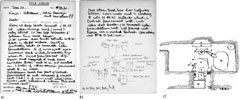 objects only become clear when studying their provenience and their spatial association with other artifacts. This work is possible thanks to extensive documentation made during the recovery of the objects; these records were kept in notebooks, on plans, section drawings, excavation photographs, locus cards, sketches, in unpublished manuscripts, and generally contain a level of detail that surpasses any published excavation account (Figure 8). In the past decades several scholars have shown the promise and potential of “re-excavating” old excavations on paper by re-examining excavation records, and Reichel's dissertation has shown an unusually high level of potential for the Diyala sites. At present, however, scholars from outside the Oriental Institute would know little if anything about the Diyala field recording system. Even if they came to Chicago to examine the records, they would not even know what to ask for. We decided therefore to scan ALL archival material, published and unpublished, to include it in our database, and to make it available to the scholarly community worldwide via the World Wide Web. This will not only stimulate more research on the Diyala material, but also create an important virtual backup of this data. The very real danger of losing irreplaceable documentation can not be overstated. Some of the plans and notebooks at the Oriental Institute have already deteriorated significantly and will soon be too fragile to be handled. Gradual decay, however, is only one of the perils that paper records face. The ransacking of the Iraq Museum’s archives in April not only made it a slow process for museum officials to provide an exact tally of stolen objects, but will also make it significantly more difficult for scholars to study archaeological corpora such as the Diyala material in Baghdad. Having all of our records available on the web will not only be of invaluable help in scholarly research but also in the reconstruction of the museum’s collection.
objects only become clear when studying their provenience and their spatial association with other artifacts. This work is possible thanks to extensive documentation made during the recovery of the objects; these records were kept in notebooks, on plans, section drawings, excavation photographs, locus cards, sketches, in unpublished manuscripts, and generally contain a level of detail that surpasses any published excavation account (Figure 8). In the past decades several scholars have shown the promise and potential of “re-excavating” old excavations on paper by re-examining excavation records, and Reichel's dissertation has shown an unusually high level of potential for the Diyala sites. At present, however, scholars from outside the Oriental Institute would know little if anything about the Diyala field recording system. Even if they came to Chicago to examine the records, they would not even know what to ask for. We decided therefore to scan ALL archival material, published and unpublished, to include it in our database, and to make it available to the scholarly community worldwide via the World Wide Web. This will not only stimulate more research on the Diyala material, but also create an important virtual backup of this data. The very real danger of losing irreplaceable documentation can not be overstated. Some of the plans and notebooks at the Oriental Institute have already deteriorated significantly and will soon be too fragile to be handled. Gradual decay, however, is only one of the perils that paper records face. The ransacking of the Iraq Museum’s archives in April not only made it a slow process for museum officials to provide an exact tally of stolen objects, but will also make it significantly more difficult for scholars to study archaeological corpora such as the Diyala material in Baghdad. Having all of our records available on the web will not only be of invaluable help in scholarly research but also in the reconstruction of the museum’s collection.
2. An Oracle Backend Database
 Figure 9 shows Sundell’s present fundamental model, which shows many but not all of the tables. Structurally this layout can be divided into six "zones" (Zones I - VI):
Figure 9 shows Sundell’s present fundamental model, which shows many but not all of the tables. Structurally this layout can be divided into six "zones" (Zones I - VI):
- Zone I contains the final, "revised," information on each artifact; this is the nodal point of the layout to which every table is linked directly or indirectly.
- Zone II contains tables with information relating to the material composition of an object, allowing the listing of all composites as well as the ranking of primary and secondary materials.
- Zone III contains “dynamic data” specific to particular classes of objects, reflecting preliminary results as well as ongoing research undertaken by individual scholars. Personalized log-ins will allow authorized scholars [i.e., team members from the University of Chicago] to add or modify data and be credited for it. Varying interpretations from different scholars will be stored and displayed separately, a feature that we believe to be vital in ongoing research. The tables shown in Figure 9 reflect Clemens Reichel's work on cuneiform tablets and clay sealings; tables for other object categories, however, will be added as required.
- Zones IV and V contain information on the objects’ archaeological provenience. While physical descriptions of an object always can be updated, corrected, and improved as long as the object itself is available for analysis, we cannot add to an excavator's observations for archaeological provenience made in the field; retaining data integrity in this section is therefore of vital importance. Zone IV contains our own master layout of areas, levels, and loci of each site in a revised and standardized form. Original field notes as well as published archaeological summaries given by the excavators are provided in the tables of Zone V, giving the user the possibility to examine, evaluate, and even question our reconstruction of the archaeological sequence.
- Zone VI contains the "reference" items necessary for analysis, which include publication references, maps, plans, site and object photos, drawings and sketches of objects, as well as metadata.
3. Current State of Affairs (December 2004)
III. Project Results
1. Target Audiences
- School / general education: Our site will feature educational components that could easily be used as teaching tools in schools. By “walking” on the computer screen through the plan of a selected building, for example, students will be able to call up images and descriptions of artifacts found in each room. By showing typical information that archeologists use to date and interpret objects or to explain the function of a building, such highly interactive pages will explain visually the archaeological methods used by scholars in the field. Users will understand the significance of properly recorded archaeological provenience and see the limited scientific “value” of unprovenienced objects from the antiquities market. We hope that these pages will make the general public more aware of the irreversible damage and loss of knowledge caused by the looting of archaeological sites in search for artifacts to supply the illegal antiquities market, as it is presently happening in Iraq.
- Academic world (Ancient Near Eastern Studies): With new questions emerging following each new publication, and with new technologies for analysis constantly becoming available, no archaeological corpus in our field can ever be considered “fully” analyzed. For that reason we plan not only to retain our “dynamic data section” (= Zone III in Figure 9) indefinitely but also to expand it continuously to enable scholars to add data and to actively pursue their research through this database. Much of the analyses on Diyala material could be done as research for Ph.D. dissertations on topics addressing political, social, and economic history, and chronology of the ancient Near East. What makes this idea particularly attractive is that, once the Diyala material is up on the web, these dissertations could be written not just in Chicago but literally anywhere in the world, making it possible for students at institutions with very limited funds to work on this material. These studies could be added as narrative extensions to our site and cross-linked with descriptions of object or archaeological contexts in our database.
- Academic world (interdisciplinary): On an interdisciplinary level we hope that our project may further the exchange of ideas and conceptual approaches between Near Eastern archaeology and related academic disciplines. Compared to Near Eastern scholars, for example, scholars working in European and Meso-American archaeology have developed much more sophisticated theoretical frameworks for topics such as state formation, political ideology, social complexity, economic interactions, and craft specialization. This is regrettable since ancient Mesopotamia not only provides a wealth of archaeological data but also an abundance of socio-political and socio-economic data in the form of textual records, while many of the European and Meso-American models are actually based on studies of non-literate societies. The surprising absence of interdisciplinary cooperation is largely due to the high degree of specialization found in most publications on ancient Near Eastern archaeology and history, making this data inaccessible not only to lay persons but also interested scholars in other disciplines. The Diyala material could provide a large yet easily accessible data pool to test theories developed in non-Near Eastern context on political, technological, and social mechanisms in a different cultural and geographical setting, allowing scholars to evaluate the universal applicability of their models. In return, these models could help to develop more refined theoretical frameworks for Near Eastern archaeology.
2. The Diyala as a “Template” for other Projects
IV. Project Team
- Clemens Reichel (principal investigator): Reichel has worked on the the Diyala material since 1996, first as a student assistant, after completion of his dissertation in 2001, as research associate and project coordinator. His dissertation research on the artifact pattern in a palatial complex at one of the Diyala sites (Tell Asmar), and his background in computer database management make him uniquely qualified to be the project’s coordinator. His analytical work on seals, sealings, and cuneiform tablets from the Diyala and elsewhere have resulted in several published articles and manuscripts. Reichel will instruct and supervise the student assistants, complete the layout of the database backend (with Sundell), work on the project’s web interface (with Sundell and an NSIT programmer, see below), and control the integrity of the data entries.
- McGuire Gibson (senior advisor): Having directed major archaeological excavations in Iraq (Nippur,Üç Tepe, Umm-al Jir, Umm al-Hafriyat) since 1964, Gibson has been well acquainted with the material culture of Mesopotamia (including pottery, seals, sculpture); few people are as familiar with the major questions and problems in the reconstruction of Mesopotamia’s cultural history and chronology as Gibson is. He is very familiar with the Diyala material, having published a critical study on its archaeological chronology. Gibson will advice Reichel and student assistants on issues of chronology, terminology, and archaeological standards.
- George Sundell (data architect / consultant): A retired data architect for SBC/Ameritech, Sundell has been creating layouts for relational databases for many years. Sundell has taken classes in background in American archaeology, participated in numerous field projects, and retained an active interest in archaeology throughout his professional career. This combination of professional expertise and personal interest makes Sundell an ideal candidate for database architect, coordinating with the operational database administrator. During 2004/2005, Sundell, in cooperation with Reichel, will complete the layout of the Diyala database backend in Oracle and transfer the data from FoxPro. In 2005/2006, Sundell will serve as database designer, maintaining the database and implementing structural changes to the layout where necessary.
- Student assistant (name t.b.a.): This student's primary task will be the verification, edition, and standardization of descriptive data entries, based on comparison with available objects, photographs, or drawings, as well as digital work (manipulation of object photograph with Adobe Photoshop; input of scans of locus sheets, field registers, and object cards). His / her work will be supervised by Reichel.
- Student assistant (name t.b.a.): Principal task will be the supervision of scanning of maps, architectural plans, and field records, and the digital enhancement (vectorization) of architectural plans and topographical maps. He / She will also be working on the digital enhancement of object photographs. His / her work will be supervised by Reichel.
- Betsy Kremers (volunteer): a former museum docent, Kremers has been working as the project's photographer since 1998. In the past six years she has taken over 6,000 new photographs of Diyala objects at the Oriental Institute Museum. Kremers is presently working on tablets from Tell Asmar dating to the Ur III-Isin/Larsa period, a project that should be completed by late 2005.
- Robert Wagner (volunteer): a retired translator from German to English, Wagner joined the Diyala Project as a volunteer in March 2004. One of his first tasks for the Diyala Project was the transcription and translation of those field records that had been kept in German. Since May 2004 he has turned his attention to scanning the Diyala locus and object cards. Beginning in January 2005, Wagner will scan the Diyala Field photographs (both object photos and excavation photos). His work is supervised by Reichel.
- Karen Terras (volunteer): a former Oriental Institute museum docent and "veteran" of the Oriental Institute's Iraq Museum Database, Terras already has extensive experience in data entering and digital capture of photographs as well as archival material. She joined the Diyala Project in May 2004. During 2004/2005, she will scan the Diyala field notebooks and index them for archaeological contexts (area, level, locus numbers) described in these records. Beginning in 2005, Terras will also participate in the scanning of the original Diyala field photographs. Her work is supervised by Reichel.
- (Programmer, Network Servicing and Information Technology, University of Chicago, name t.b.a.): upon completion of the Oracle database backend, a programmer will create the browser interface for the Diyala website in 2005/2006. This work will be done jointly with Reichel and Sundell.
V. Proposed Plan for Completion of Project
- July 2004: Completion of data transferal to the Oracle backend database (Reichel, Sundell)
- July-September 2004: Revision of data layout (Gibson, Reichel, Sundell), creation of stored procedures (Sundell)
- July 2004-June 2005: Scanning of field notes, plans and remaining photographs (Terras, Wagner)
- December 2004-December 2005: Indexing of newly scanned data (Terras, student assistants)
- January 2005-December 2005: Consecutive addition of newly scanned data to database (student assistants)
- January 2005-December 2005: Creation of the browser front end, screens, XML / Java interface for database (Reichel, Sundell, Network Servicing and Information Technology [University of Chicago])
- January-April 2006: Editorial work: mark-up and cross-referencing of plans, object cards, site photos, etc. for screen display (Reichel + student assistants)
- May-June 2006: Final revisions
- Projected completion / date of launch: July 2006
VI. On-line Publications and Reference Items
- Annual Report 2007 - 2008
- Annual Report 2006 - 2007
- Annual Report 2004 - 2005
- Annual Report 2003 - 2004
- Annual Report 2002 - 2003
- Annual Report 2001 - 2002
- Annual Report 2000 - 2001
- Annual Report 1999 - 2000
- Annual Report 1998 - 1999
- Annual Report 1997 - 1998
- Annual Report 1996 - 1997
- Annual Report 1995 - 1996
Publications by Clemens Reichel:
- Political Changes and Cultural Continuity at the Palace of the Rulers in Eshnunna (Tell Asmar) from the Ur III Period to the Isin-Larsa Period (ca. 2070 - 1850 B.C.). Dissertation Proposal (1996). University of Chicago: Department of Near Eastern Languages and Civililzations (submitted in 2001).
- “Clay sealings and tablets from Tell Asmar: an ancient Mesopotamian palace reinvestigated,” Oriental Institute News & Notes Fall 1998: 1 - 5.

